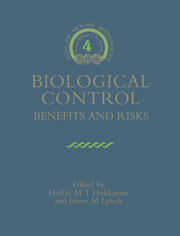Book contents
- Frontmatter
- Contents
- List of Contributors
- Series Preface
- Preface: Overview of Benefits and Risks of Biological Control Introductions
- Part I Biological Invasions
- Part II Classical Biocontrol
- Part III Augmentative Biocontrol
- 9 The Use of Exotic Organisms as Biopesticides: Some Issues
- 10 Use of Trichogramma in Maize – Estimating Environmental Risks
- 11 Entomopathogenic Nematodes in Biological Control: Feasibility, Perspectives and Possible Risks
- 12 Pseudomonads as Biocontrol Agents of Diseases Caused by Soil-borne Pathogens
- 13 Biological Control of Soil-borne Pathogens of Wheat: Benefits, Risks and Current Challenges
- 14 Genetically Engineered Fluorescent Pseudomonads for Improved Biocontrol of Plant Pathogens
- 15 Biological Control of Foliar Fungal Diseases
- 16 The Use of Fungi, Particularly Trichoderma spp. and Gliocladium spp., to Control Root Rot and Damping-off Diseases
- 17 Bacillus thuringiensis in Pest Control
- 18 Opportunities with Baculoviruses
- Part IV Use of Genetically Modified Organisms
- Part V Economics and Registration
- Index
13 - Biological Control of Soil-borne Pathogens of Wheat: Benefits, Risks and Current Challenges
Published online by Cambridge University Press: 07 May 2010
- Frontmatter
- Contents
- List of Contributors
- Series Preface
- Preface: Overview of Benefits and Risks of Biological Control Introductions
- Part I Biological Invasions
- Part II Classical Biocontrol
- Part III Augmentative Biocontrol
- 9 The Use of Exotic Organisms as Biopesticides: Some Issues
- 10 Use of Trichogramma in Maize – Estimating Environmental Risks
- 11 Entomopathogenic Nematodes in Biological Control: Feasibility, Perspectives and Possible Risks
- 12 Pseudomonads as Biocontrol Agents of Diseases Caused by Soil-borne Pathogens
- 13 Biological Control of Soil-borne Pathogens of Wheat: Benefits, Risks and Current Challenges
- 14 Genetically Engineered Fluorescent Pseudomonads for Improved Biocontrol of Plant Pathogens
- 15 Biological Control of Foliar Fungal Diseases
- 16 The Use of Fungi, Particularly Trichoderma spp. and Gliocladium spp., to Control Root Rot and Damping-off Diseases
- 17 Bacillus thuringiensis in Pest Control
- 18 Opportunities with Baculoviruses
- Part IV Use of Genetically Modified Organisms
- Part V Economics and Registration
- Index
Summary
Introduction
Why biological control?
The past 15 years have witnessed a dramatic increase in research related to biological control. The current perception that biocontrol will have an important role in commercial agriculture in the future contrasts markedly with previously-held views that biocontrol agents perform too inconsistently, or are too narrow in their spectrum of activity, as compared with chemical pesticides, to be commercially feasible on a large scale. Renewed interest in biological control is in part a response to widespread concern about the potential negative impact of chemical pesticides on public health and the environment. Furthermore, the techniques of molecular biology have revolutionized the field by facilitating the identification of the molecular basis of pathogen suppression and by providing the means for construction of ‘superior’ biocontrol agents. New biocontrol agents resulting from recent intensive research are slowly becoming available to agriculture, and the trend should accelerate throughout this decade. One example is Gliocladium virens, which is being marketed in potting-mix to control Pythium and Rhizoctonia (see Lumsden and Walter, Chapter 25).
This chapter deals with the potential benefits and risks from the introduction of biocontrol agents for the control of root diseases of wheat, as well as the impediments to the application of this technology in commercial agriculture. The focus of the chapter is on biological control of take-all of wheat by fluorescent Pseudomonas spp. because it is a model system for the study of the molecular basis of pathogen suppression, root colonization by introduced bacteria and field application of biocontrol agents.
- Type
- Chapter
- Information
- Biological ControlBenefits and Risks, pp. 149 - 160Publisher: Cambridge University PressPrint publication year: 1995
- 2
- Cited by



